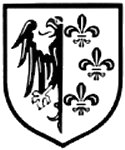The SS (Schutzstaffel): 33rd Waffen Grenadier Division of the SS Charlemagne (1st French)
 |
The 33rd Waffen-Grenadier-Division der SS Charlemagne (französische Nr. 1) and Charlemagne Regiment are collective names used for units of French volunteers in the Wehrmacht and later Waffen-SS during the World War II.
The Charlemagne division was not a single military unit but succession of groups of collaborating French volunteers (though the exact nature of "volunteering" has been disputed). The first unit was the Légion des Volontaires Français (Legion of French Volunteers or LVF), mainly composed of right-wing Frenchmen and released French soldiers who preferred fighting to forced labour in Germany. It fought near Moscow in November 1941 but its commander, Colonel Roger Balonne, was later relieved of his duties and in 1942 the men were assigned to anti-partisan duties in the Byelorussian SSR (Belarus). They were briefly joined by La Légion Tricolore (Tricolor Regiment) but this unit lasted only six months in 1942 and was later absorbed into the LVF.
The unit (without a French commander) was attached to various German divisions until June 1943 when Colonel Edgard Puaud took command. The LVF fought on the Ukraine front against the Soviets in 1944.
In the meantime, in July 1943, a new recruiting drive had begun in Vichy France. It attracted 3000 applicants, mostly members of collaborating militias and university students. This unit (Französische SS-Freiwilligen-Sturmbrigade) was sent to Galicia to fight the Soviet advance and suffered heavy casualties. It was later absorbed into the LVF. In late 1943 the surviving LVF/Sturmbrigade volunteers were inducted into the Waffen-SS Französische SS-Freiwilligen-Grenadier-Regiment (Waffen-SS French SS-Volunteer Grenadier Regiment.)
In September 1944 this unit was renamed Waffen-Grenadier-Brigade der SS Charlemagne, with the addition of French collaborators fleeing the Allied advance in the west, as well as Frenchmen from the Horst Wessel brigade and Organisation Todt. Others came from the Vichy French Milice and other collaborationist organizations. Some sources claim that the unit included also volunteers from French colonies and Switzerland. SS-Brigadeführer Gustav Krukenberg took actual command with Edgard Puaud (now Oberführer der SS) as nominal French commander.
In February 1945 the unit was officially upgraded to a division and renamed 33.Waffen-Grenadier-Division der SS Charlemagne. However, the unit was severely undermanned with only 7340 men. The division was sent by train to fight against the Red Army in Poland, but on 25 February it was attacked while deploying from the railhead by troops of the Soviet 1st Belorussian Front and was broken into three battlegroups. Only the units with Krukenberg survived, as they retreated to the Baltic coast, were evacuated by sea to Denmark and later sent to Neutrelitz for refitting.
In early April 1945, Krukenberg, now commanding only 1100 men, released those who were disillusioned from combat service; about 700 men chose to remain. The other 400 men were formed into a construction battalion.
On 24-25 April 1945 elements of the unit were ordered to Berlin and placed under the command of SS-Standartenführer Walter Zimmermann, reaching the city before the Soviet encirclement. They fought in the Battle of Berlin until 2 May 1945, when thirty survivors surrendered to the Russians.
Sources: Wikipedia


